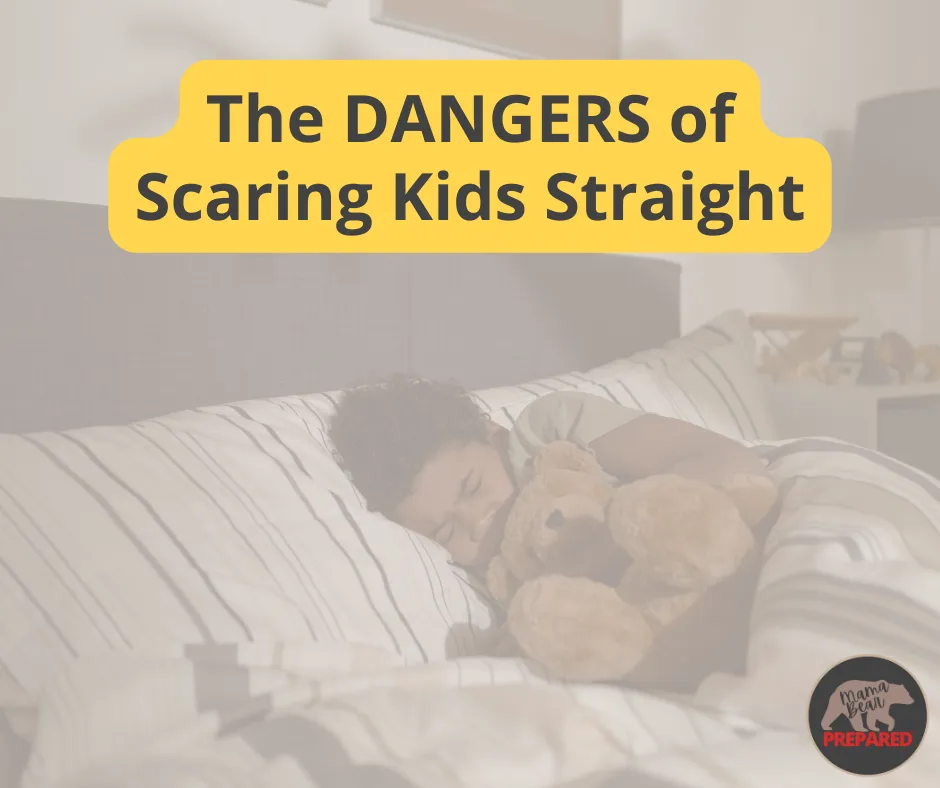
The Dangers of Scaring Kids Straight
Crippling Anxiety Is Not the Solution: How to Teach Your Child Safety Without Fear
As parents, we all want to keep our children safe. But sometimes, in our effort to protect, we unintentionally rely on strategies that create anxiety instead of empowerment. Scaring children into compliance may seem effective—but it can actually make them more vulnerable and less capable of making safe decisions.
Why Scare Tactics Backfire
Many of us have heard or even tried advice like “shock them into obedience” or “scare them straight.” While these methods may achieve short-term compliance, they are not effective for long-term safety.
Definition of scare tactics: “To shock or frighten someone so severely that their bad behavior or actions become corrected” – The Free Dictionary
Frighten: “To make afraid or fearful; terrify; scare” – Dictionary.com
Here’s the problem: terror may create compliance, but it also creates anxiety, dependence, and fear - which is the exact opposite of what makes a child difficult to take advantage. Children who are terrified are less likely to:
Recognize their own gut instincts
Make safe choices independently
Develop confidence in discerning unsafe situations or people
The Effects of Creating Anxiety or Fear
Children who have been taught to comply through fear most always lack confidence in their own judgment and may exhibit symptoms of anxiety and distrust. Recognizing these signs can help you intervene early and empower your child to trust themselves and make safe choices.
Common Symptoms Include:
Excessive worry or fear about everyday situations that most children handle easily
Avoidance behaviors – reluctance to try new things, meet new people, or go to school or activities
Over-reliance on adults – needing constant reassurance or permission before making decisions
Physical symptoms of anxiety – stomachaches, headaches, trouble sleeping, or frequent complaints of illness
Difficulty expressing feelings – hesitation to share concerns or report uncomfortable situations
Hyper-vigilance or fear of people – being suspicious of others or overly cautious around friends, teachers, or caregivers
Low self-confidence in decision-making – doubting their own judgment or second-guessing choices constantly
Emotional outbursts – tantrums, crying, or anger stemming from fear or uncertainty
These signs are not just “behavior problems”—they are indicators that your child may feel powerless or unsure about how to protect themselves. Teaching children to trust their instincts, recognize real danger, and make decisions confidently can reduce these symptoms and help them develop lifelong safety skills.
Teaching Children to Trust Their Gut
Safety isn’t about fear—it’s about empowerment. Children need to learn the difference between:
Worry: Overthinking or unnecessary anxiety that blocks awareness
Legitimate fear: That internal gut instinct that signals real danger
When we rely on scare tactics, we can drown out our child’s ability to hear their internal voice, leaving them less prepared to recognize real threats.
Learning Safe Living Through Play
Safety education doesn’t have to be terrifying. In fact, children best learn through games, stories, and hands-on practice.
Lighthearted activities help children internalize lessons without anxiety
Fun, realistic scenarios teach kids how to respond safely in daily life
Consistent practice builds confidence, judgment, and independence
Even if you’re not naturally “fun,” there are plenty of tested games and resources available to guide safe living lessons.
Empower Your Child With a Safety Plan
Instead of fear-based learning, consider a practical safety plan your child can use right now:
Ask the right questions: Talk with your child about their understanding of safety, boundaries and the reasons for rules.
Give your child controlled freedom. Allow your child strategic space to make mistakes and learn. Independence and experience is paramount.
Help Your Child Trust and Rely on Their Instincts: Your gut is an important guide for noticing when something is wrong. Empower your child to hear and trust theirs.
If you want step-by-step instructions for a Safety Plan your child can actually use, check out our quick, simple eGuide:
[Empower Your Child With a Safety Plan]
Practical Tips for Parents
Many of us have used fear tactics because we thought it was the best way to keep our children safe—and that’s okay. We do the best we can with what we have. If that approach works for your family, continue doing what feels right. But if it’s not a good fit, now that we know better, we can do better. There are simple tools and strategies that empower children to be safe—without fear.
We need to see children develop and demonstrate good judgment, and until they show us they’re ready, we must balance giving freedom with taking control. Keeping our kids safe is our responsibility.
If you’re ready to start teaching safety with confidence and care, here are some ways to get support and practical resources:
➡️ [Join the Mama Bear Community.]
(Het support from likeminded mamas to have the courage to ask tough questions and do hard things)
➡️ [Get age-appropriate and solution-oriented books to empower kids with a Safety Plan here]
(Most of the books on safety out there do more harm than good. Enjoy the list we compiled that empowers children ages 2-8 with a plan)
➡️ Do you doubt your own power and intuition? We cannot teach our children what we don't know. [Get our 7 Days to Sanity Workbook here.]
Join the Conversation
What strategies have worked for you to teach your child safe living without creating fear or anxiety? Share your experiences below—your insight can help other parents feel empowered too!